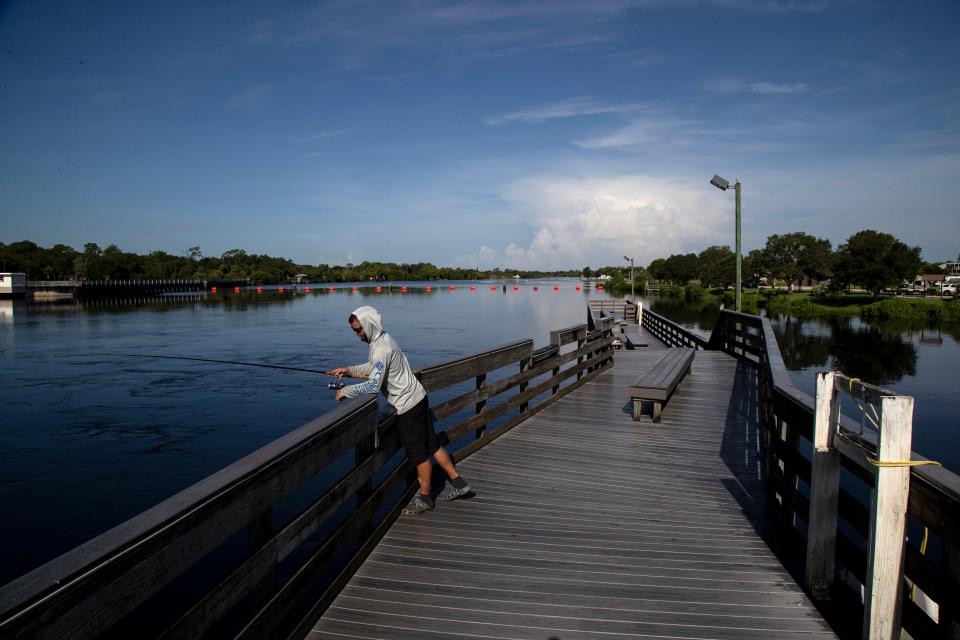Lake Okeechobee leveling off after rains from Hurricane Ian. But there's still a threat.
The Lake Okeechobee drainage system is more likely to see a blue-green algal bloom next spring as a result of Hurricane Ian.
Lt. Col. Todd Polk, with the U.S. Army Corps of Engineers, said Ian whipped up waters and stirred nutrients within the system, and that those nutrients could fuel a bloom.
That's what happened in 2018, when nutrients in Lake Okeechobee were stirred up by Hurricane Irma (2017).
Those nutrients fed a bloom on the lake in the early summer of 2018. Soon after, a particularly strong blue-green algae bloom gripped the Fort Myers-Cape Coral area for months. Water flowed about 70 miles from the lake, down the Caloosahatchee and miles into the Gulf of Mexico.
Some homeowners in areas like downtown Fort Myers and Cape Coral rented hotels or sold their homes to escape the impacts from blue-green algae.
They reported breathing issues and an overall stench that summer and fall.
Florida hurricane forecast: Amid Ian cone-troversy, season could see quiet conclusion | WeatherTiger
Helping hands: Where to offer time, money, food and other supplies for Hurricane Ian victims
The impact of blue-green algae and red tide
Combined with a red tide that is thought to have been fed by those same nutrients, the algal blooms killed tons of marine life, and the tourism and recreational fishing industries suffered.
"We realize the lake inflows and the amount of winds will increase the risk of algal blooms this next year," Polk said. "Unlike storms that went directly over the lake that really churned up the lake, there’s still a lot of turbidity coming down and a lot of nutrient loading, and that is of greater concern."
Blue-green algal blooms can wreak havoc on everything from the environment to the economy.
Strong blooms kill marine organisms and cause waters to be murky and carpet-like.
The surface of the lake was at 15.9 feet above sea level on Nov. 2, according to South Florida Water Management District records.
Lake Okeechobee is often referred to as the liquid heart of the Everglades. At 730,000 square miles, the massive waterbody was likely not connected historically to the Caloosahatchee River.

Decades ago the Caloosahatchee River was connected to the lake and is now used as a floodplain. The river starts as a straight canal.
But the river needs flows from Lake Okeechobee during dry times, when very little water is flowing off the basin landscape.
Lake Okeechobee was several feet below the desired levels in mid-September. But Hurricane Ian caused the level to rise for weeks after the storm.
"It's gone up more than two-and-a-half feet and it's going to go up some more but a month ago we were at 13 feet; and if we had not got this we would have droughts next season and we'd all be fighting over the water," said Audubon scientist Paul Gray after the storm. "One month ago, that's what it looked like."
Crisis response: Guest opinion: NCEF implements 'Crisis Response Toolkit' after Hurricane Ian
Railway bridge destruction: Officials get close-up look at damaged Seminole Gulf Railway bridge in Fort Myers
Gray said overall that the lake is in relatively good condition.
Waters will be deep enough for snail kite nesting, and the lake water has reached into the marshes.
"This also leaves enough water in the lake to give base flows to the Caloosahatchee River," Gray said.
Calusa Waterkeeper John Cassani said he expects future conditions will favor algal blooms, making them more frequent and longer-lasting.
"I think the trend for the winters is warmer and drier, and if that's the case that will impact the natural system," Cassani said.
The National Oceanic and Atmospheric Administration, or NOAA, is calling for above-average temperatures and average rainfall between now and the end of the year.
Rains have been sparse in the past two weeks as the dry season started on Oct. 15.
Right on cue, daily weather patterns have switched from afternoon thunderstorms to just plain old hot.
Highs have been unseasonably warm, and some weather experts expect drought conditions here between now and the next rainy season (May 15, 2023).
The lake, for now, though, is doing well, Polk said.
"We expect we’ll have more clarity on the lake topping out in the next few weeks," Polk said.
Connect with this reporter: @ChadEugene on Twitter.
This article originally appeared on Fort Myers News-Press: Blue-green algae bloom likely on Lake Okeechobee in 2023

